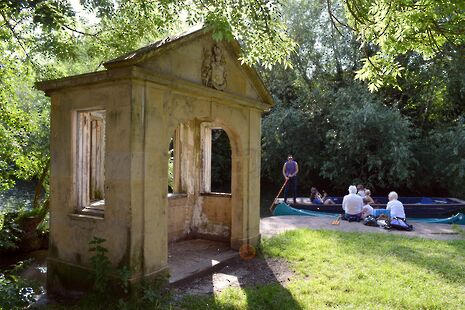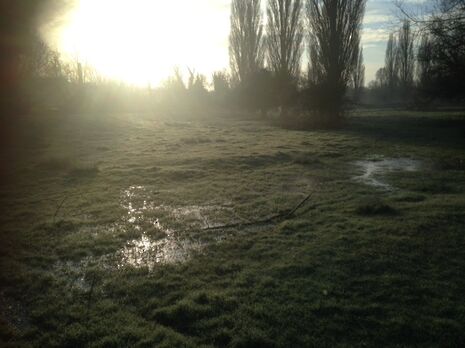To Grantchester through the Fens
From Byron to Pink Floyd, a walk to Grantchester has much to offer

Walking to Grantchester is one of those things a student really ought to do for the full Cambridge experience, like attending a may ball, or writing a Crushbridge, or getting papped by The Daily Mail on Caesarian Sunday. But what exactly is so special about this little village, only two miles down the road? Can it really be anything like the Arcadia of Brooke’s poem? Is it all my imagination, fuelled by the wistful recollections of alumni, cracked it up to be? Now is the time to find out, the sun gloriously hot above the libraries; at the very least, the walk offers a few hours’ procrastination more wholesome than getting lost in the meme-sphere and maybe even a sweet if momentary escape from that pesky anxiety of Exam Term.
Once upon a time these fens were a roaming ground for Cambridge’s Romantics
My route involves a slightly circuitous, slightly muddy wend through the fenlands, beginning at Laundress Green – the name, as so many in this area, a lasting relic of its past function – and headed south towards the Fen Causeway. All through here, a veiny sprawl of offshoots from the Cam is vital in the summer’s heat, but floods most of the land in winter, as my favourite pair of socks found out in the cruellest possible way. Once upon a time these fens were a roaming ground for Cambridge’s Romantics, with Byron’s Pool only a little further upstream. More recently (as legend has it, and grainy YouTube footage would seem to confirm), they have proved formative raving grounds for certain members of Pink Floyd: the echoes of a distant time come willowing across the air, as Roger Waters would nearly go on to write, presumably once he’d sobered up a touch.
For those similarly untroubled by strict Exam Term timetables, it’s worth making an exploratory detour to find the so-called Hodson’s Folly, a rare spot hidden from Google Maps cameras by an overgrown and otherwise redundant little wall. Built by a Pembroke College butler named John Hodson in 1887 – apparently planning permission wasn’t such a big deal back then – this odd, classical stone gazebo provided its creator with a spot for watching over his young daughter as she swam the Cam, and bears a coat of arms depicting a swan battling against the rain, humorously if now faintly captioned ’fait bien’. Acquired by the city council in 1936, the Folly has since fallen into disrepair if not quite disuse: its walls are now adorned with sadly unoriginal graffiti, of the sort that only an early-days stoner could find amusing.

From here, head across a bridge and through a car-park to find Paradise, a nature reserve whose name might appear sweetly ironic or utterly sincere, depending (so I’m told) on how closely one adheres to the Folly’s scribbled counsel. Whatever your perspective, this island in the fens is unmistakably beautiful, all willows aslant and walkways rough-cut; even the informative screed at the reserve’s entrance has a fairy-tale sensibility, boasting of red flowers from the ‘Lady’s Smock’ first noted here in the 1600s and of dragonflies and damselflies patrolling the marshy air. For the superstitious among you, this Paradise was also the scene of a curious tragedy: in 1811 the libertine Charles Matthews, a student friend of Byron’s, became entangled in the weeds and drowned in the shallow waters. Some say his ghost can be seen in the ripples of the waterways at dusk, but I for one have never hung around long enough to be sure.
At the confluence of Paradise’s streams the path to Grantchester opens up again: it’s onwards through the meadows, if you’re somehow comfortable traversing fields of huge, beefy cows – I needed my hand held the whole way, and I refuse to be ashamed of that – or else along the road proper, where the only danger comes from a shortage of pavement, or perhaps a crippling sense of our encroachment upon nature. However you get there, the village itself has a few must-sees: its quaintly thatched Village Hall, the Church of St. Mary and St. Andrew’s (possibly) Norman font, the Old Manor which is said to contain a secret passage straight to King’s College Chapel; seek refreshment at the Orchard Tearooms, before heading next-door to drink in the Old Vicarage itself.
When I get there, though, it is sunset, the village sleepy and the tearooms closed; I cannot answer Brooke as to the honey, so I am persuaded to reflect on a journey incomplete in the smart gastropub that bears his name. “Unforgettable, unforgotten” is the only line I can recall in full; and what a sweetly trite conclusion, you say, where the journey is what counts – but wasn’t the point to tell about the town? Well, my column inches are precious few, and some things seem best left to the imagination.
 News / Downing investigates ‘mysterious’ underground burial vault 29 December 2025
News / Downing investigates ‘mysterious’ underground burial vault 29 December 2025 News / Unions protest handling of redundancies at Epidemiology Unit30 December 2025
News / Unions protest handling of redundancies at Epidemiology Unit30 December 2025 Lifestyle / Ask Auntie Alice29 December 2025
Lifestyle / Ask Auntie Alice29 December 2025 Features / ‘Treated like we’re incompetent’: ents officers on college micromanagement30 December 2025
Features / ‘Treated like we’re incompetent’: ents officers on college micromanagement30 December 2025 Science / Astronomical events to look out for over the break29 December 2025
Science / Astronomical events to look out for over the break29 December 2025










